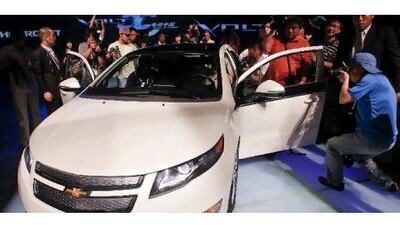Japanese pride is at stake in the fight for top spot in green vehicles. The country's biggest car maker faces challenges from the US, China and domestic rivals
Mention green cars and the name that comes to the minds of many consumers is Toyota and its market-defining hybrid, the Prius.
And it's not only a winner for Toyota. The vehicle allows Japan to keep its technological cool and has given it hope that it won't always be stuck in the economic doldrums as neighbouring China, now the world's second-biggest economy, races ahead.
But for the world's top car maker there is the angst of being at the top with no way to go but down. To stay number one, the Japanese car giant will have to deploy the full array of its technological weaponry.
The Toyota boss Akio Toyoda need only look at Sony, the inventor of mobile music with its Walkman, to see how easy it is to become a byword in a technology you pioneered. Toyota is the Sony of green cars. The question for Mr Toyoda is, can it be the Apple too?
Competitors for Toyota's title are both home-grown and foreign. Among them is General Motors (GM), the company Toyota toppled to become the biggest car maker three years ago.
Having dropped high costs and the stranglehold of union rules that forced it to operate as a 1970s companies in the 21st century, the US car giant has chosen electric vehicles to do battle with Toyota.
Last November, GM announced plans to hire 1,000 engineers to expand its range of electric cars after launching its Chevrolet Volt, a vehicle with a Korean-built lithium battery and 1.4-litre engine the company says is cheaper to run than the petrol-sipping Prius.
It is a boast the US environmental protection agency agrees with, rating it with a capacity of 60 miles to the gallon compared with 51 for the Prius.
Bailed out with taxpayers' money, GM has even had a helping sales hand from the US President Barack Obama. In Europe last year for a Nato summit, Mr Obama made time to tout the Ampera, the name GM's European Opel subsidiary has given to the Volt.
At home Toyota, as always, contends with Honda, but it may face its toughest challenge from Nissan. The Renault-controlled car maker is hoping to grab Toyota's green crown with its Leaf electric car. It is a bolder idea than GM's because the car doesn't come with the crutch of a petrol engine and therefore must make it between sockets solely with the energy stored in its batteries.
As part of the marketing razzamatazz that Nissan and its boss, Carlos Ghosn, are renowned for, the company last month delivered its first Leaf to a technology entrepreneur in California, who plugged in his new car for the world's media.
But for Toyota, the biggest worry may be China's determination to lead the green car pack.
Still way behind the Japanese, the Americans and Europeans, Chinese companies such as SAIC Motor and Chery Automobile may make up for technological weakness with a helping hand from bureaucrats who are able to control access to the world's biggest car market by volume. That market is set to explode along with further economic growth.
In just five years China wants its motor companies to be building as many as 1 million electric cars a year, equal to 10 per cent of cars currently sold there.
That may mean a smaller piece of the pie for Toyota, Nissan and GM, which will have to compete on quality rather than price because subsidies the government in China is using to persuade drivers to go green are likely to be used to buy vehicles made in that country.
Toyota's response to the competition is a host of new models. It plans to launch 11 hybrid models, a range that none of its competitors can yet match.
It is also preparing a plug-in hybrid seen as an answer to the critics who say it has focused too much on hybrids at the expense of purely electric vehicles.
All of them, Toyota insists, will be more affordable. To that end, the company is tapping into the talents of the Silicon Valley start-up Tesla Motors, a partnership that could greatly reduce the cost of making batteries.
Accounting for as much as half of a green car's price tag, making those power packs cheaper is probably the biggest technological hurdle faced by all car companies.
Yet for all the green hype, petrol-driven cars are still going to outnumber environmentally friendly vehicles for many more years. Even the most optimistic industry analysts still expect that by the turn of the next decade only one in 10 cars to be green, and then only with the help of state subsidies.
So for Toyota and the Japanese, winning the green car vehicle race may seem all important, but they cannot forget to keep their petrol-guzzling customers happy too.
And they want what they've always wanted - good-looking, well-priced, reliable cars that every now and then can deliver a little bit of oomph.

